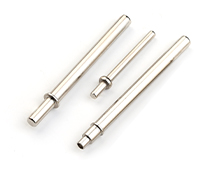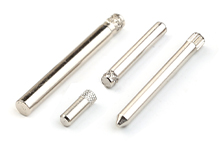In lathe machining, centering long shaft parts is a crucial first step. The accuracy of the center hole directly affects the positioning accuracy of subsequent clamping and turning, as well as the overall machining quality. If there is a deviation in the center hole, it will cause the long shaft to rotate unsteadily, leading to vibration, out-of-tolerance ovality, or even scrapping. Mastering the following clever methods can effectively ensure the quality and efficiency of the center hole.
1. Straightening the Blank and Flattening the End Face are the Foundations
Before drilling, it is essential to ensure that the long shaft blank is relatively straight without significant bending. More importantly, the shaft end face should be processed to be flat in advance. A rough end face that is not perpendicular to the axis will cause the center drill to deflect when cutting in, resulting in an incorrect center hole. A 45° external turning tool can be used first to turn the end face flat, creating an ideal guiding plane for the subsequent center drill.

2. Skillful Use of Four-Jaw Chuck and Precision Alignment
For long shafts with higher requirements, using a four-jaw chuck is the preferred solution. It can align the blank with micron-level precision by adjusting each jaw individually. During operation, first roughly align the workpiece with a scribing disc, then precisely align it with a dial indicator. Press the indicator needle against the outer circle of the shaft segment near the chuck, slowly rotate the spindle, observe the pointer swing, and repeatedly adjust the four jaws until the runout meets the requirements (usually controlled within 0.02mm). Although this method is time-consuming, it can ensure that the workpiece's rotation center is highly consistent with the spindle axis, fundamentally ensuring that the center hole is not skewed.
3. Center Frame Assistance to Overcome Ultra-Long Challenges
When machining ultra-long and slender shafts, relying solely on chuck clamping will cause the distal end of the workpiece to sag due to gravity, still resulting in errors when turning the end face and drilling the center hole. At this time, a center frame can be set up at the middle position of the workpiece as an auxiliary support. Pre-turn a smooth "support neck" at this position, and adjust the three support claws of the center frame to make uniform contact with it, which can significantly enhance system rigidity, effectively suppress flexural deformation, and ensure the coaxiality of the center holes at both ends.

4. Selection of Appropriate Center Drills and Cutting Parameters
According to the type of center used at the shaft end (such as a 60° ordinary center or a B-type center with a protective cone), correctly select type A or type B center drills. During drilling, the spindle speed should not be too low, and sufficient cutting linear speed should be provided. The feed should be uniform and stable, and sufficient cutting fluid should be applied for cooling and lubrication to protect the drill bit, ensure smooth chip removal, and ultimately obtain a smooth and dimensionally accurate center hole.
In summary, machining the center hole of a long shaft is by no means simply "drilling a hole", but a precise preparatory process that integrates alignment, support, tool selection, and parameter setting. Through rigorous blank preparation, precise four-jaw alignment, necessary center frame assistance, and standardized operation, a solid foundation can be laid for the quality of the center hole, paving the way for efficient and high-precision turning of the long shaft in the subsequent process.